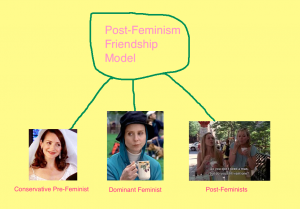In Post-Feminism and Popular Culture and Beyond Post-Feminism, Angela McRobbie classifies the new era in 1990’s modern feminism as “post-feminism” (McRobbie, 2004 & 2011). In order to commit to this classification, she acknowledges that feminism has been “cast into the shadows” and ultimately “passed away” which makes room for new idea to piggyback on the old theory (McRobbie, 2011). Confirming the end of feminism is important in order to distinguish the old theory from the new theory, there is a double entanglement seen in post-feminist women that uses ides from feminist theory as well as pre-feminist ideas. This entanglement describes the modern woman who is concerned with feminist ideals of gender equality and sexual freedom but lives with the neo-conservative ideals of pre-feminist women “in relation to gender, sexuality and family life” (McRobbie, 2004).
Figure 1. Post-feminism friendship model depicting the characters of Sex and the City as a visual representation of McRobbie’s post-feminism theory
McRobbie mentions a number of examples of post-feminist women including the female characters in Sex and the City, which introdues the idea of the “post-feminist friendship” (Fig. 1). From Figure 1, I have interpreted the roles of each character of the show into a model based on the post-feminist friendship. In order to create a post-feminist dialogue, there must be a pre-feminist character, a dominant feminist character and characters who emulate the modern post-feminist women.
Figure 1 shows Charlotte as the conservative pre-feminist woman who has maintained the 1960’s era housewife mentality relating to her family and her conservative views on sexuality. Her anxieties in finding a husband leads to a mob mentality that forces the rest of the group to obsess over their search for true love.
Miranda is the dominant feminist in the group and is vocal about her determination to live her life independently from men (Fig. 1). She is proud to be a feminist and fights for gender equality at her law firm. In this regard, she is seen as the strong female of the group and has an important role in the maintenance of the group’s female empowerment.
Finally, Carrie and Samantha embody the true modern post-feminists of the 90’s (Fig. 1). They exemplify the sexually free feminist ideals in that they converse freely about sex throughout the show and manage their own sexual lives with confidence. Samantha is an exaggerated version of Carrie but they both showcase a perfect example of a liberal woman who is “held back” by her conservative marriage goals.
Figure 2. The group
Therefore, the whole group is needed to personify the “post-feminist friendship model” in order to capture the double entanglement that is representative of post-feminism (Fig. 2).
In conclusion, these characters possess both sexual empowerment and the conservative life goals defined by the post-feminist double entanglement which exemplifies McRobbie’s definition of post-feminist theory.
References
McRobbie, Angela. “Beyond Post-Feminism.” Public Policy Research 18.3 (2011): 179-184. Business Source Complete. Web. 1 Oct. 2015.
McRobbie, Angela. “Post-Feminism And Popular Culture.” Feminist Media Studies 4.3 (2004): 255-264. Communication & Mass Media Complete. Web. 1 Oct. 2015.
Figure 1 by me on paint 2015


